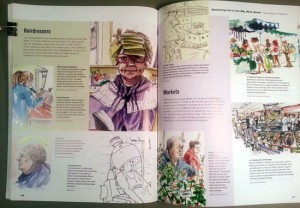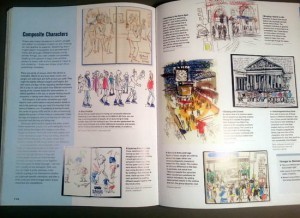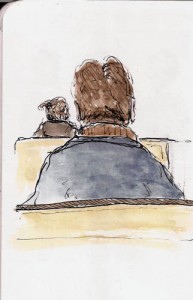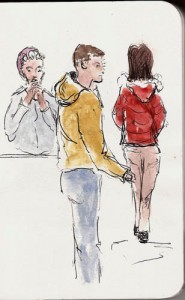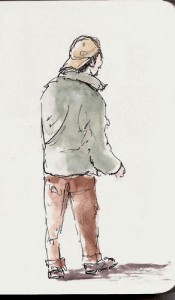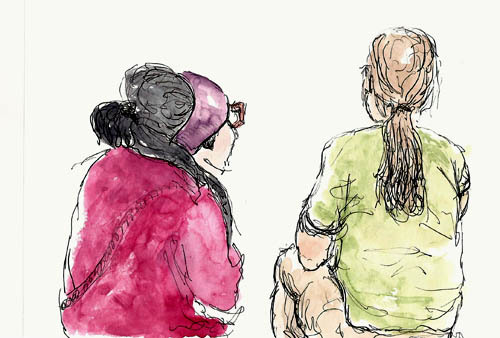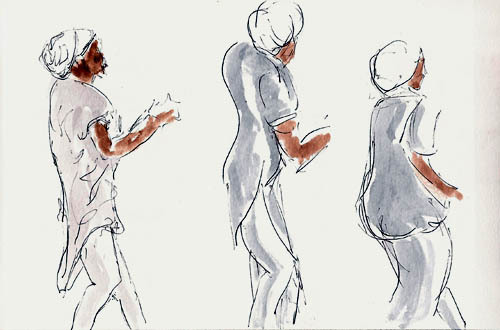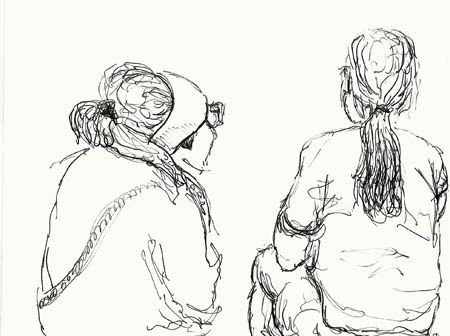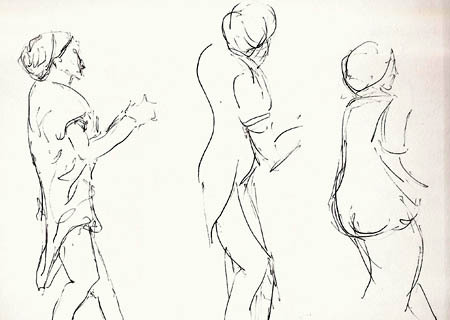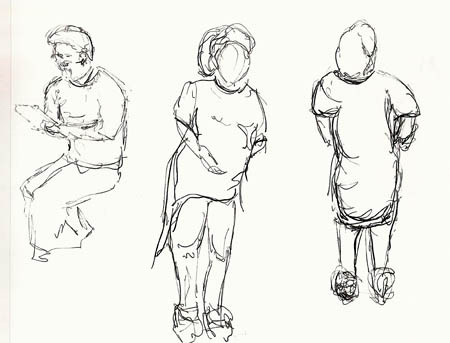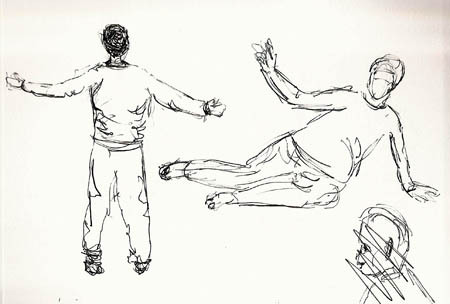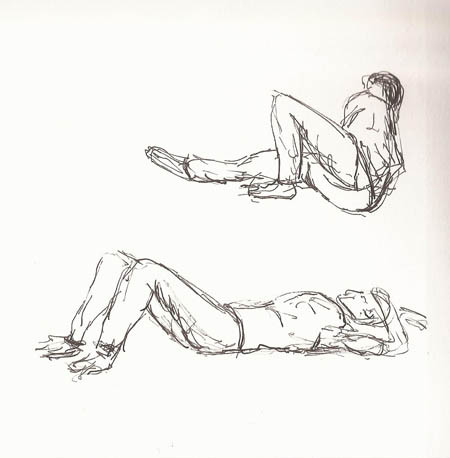Larry D. Marshall's Blog, page 57
February 29, 2016
Review: Sketching People By Lynne Chapman
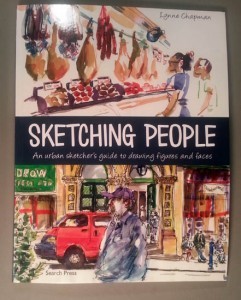 The golden age of sketching is upon us and books about it are flooding onto the market. They come in several forms.
The golden age of sketching is upon us and books about it are flooding onto the market. They come in several forms.
Lots of them are about inspiration and motivation. Seems there are a lot of folks who need to be goaded (the high-minded word is ‘inspired’) into having fun (grin). These include, however, a lot of great stuff to dismiss the myths that you have to have special genes to draw and have fun drawing. These books are probably more responsible for the sketching revolution going on than anything else.
Then there are those books that illustrate, quite literally, what it is to be an urban sketcher, nature journalist, etc. Typically these are compiled by one artist using their sketches and those from a large number of other sketchers so you get a good sampling of the styles, approaches, and subject matter associated with a particular form of sketching.
Finally there are instruction books. These books try to teach you how to sketch or how to do some particular type of sketching. As has always been the case in art book land, the majority of instruction books assume you don’t know anything about art or drawing and so spend a lot of their time telling you about color wheels, which end of the brush is the good end, and stuff like that.
Fortunately, we’re starting to see a few instructional books that assume you know something about putting pen/pencil to paper and they concentrate on particular techniques and approaches to sketching. As someone who has been sketching for a while, I welcome these books the most and Lynne Chapman’s Sketching People: An Urban Sketcher’s Guide to Drawing Figures and Faces fits into this category and I can’t recommend it enough to those wanting to improve your ability to sketch people on location. I’d even go further and recommend it to anyone wanting to improve their ability to sketch on location regardless of subject.
Production Excellence
This is not something most reviews would say much about, though more and more we’re seeing reviewers talk about the number of typos they find in books. The publishing world has been shedding editors like crazy and the impacts have become evident to anyone who is a fan of the written word. So, I want to talk about, and applaud, how Lynne Chapman and her publisher, Search Press have produced a book that is considerably better than the norm in several ways.
First, there are no typos, at least none that I saw. There are no captions on the wrong graphics. There are no grammatical errors. One caveat here is that I ordered my book from Book Depository in the UK because Amazon Canada claims that the book is not available yet. So mine is the British version of the book. In any case, this book is spotless as a result of good copy editing and proofing processes.
The book layout is simply amazing. This book is packed with information and yet all of it is readily accessible. The number of graphics they’ve managed to pack into the book, when compared to most others is wonderful, but more importantly it allowed Lynne to include a ton of information associated with those graphics in the form of paragraph-size captions.
Lastly, the overall book organization is superb. Each chapter, or set of sections leads well into the next and the knowledge gained from one chapter is built upon in subsequent sections. There’s one tiny exception…I had to find at least something to grouse about. Lynne uses a limited number of colored pencils in many of the example sketches and it’s impossible not to be asking “what colors are those” throughout the book. The answer to that question comes near the end of the book, in a section about using a limited palette. I would have liked to have known those colors sooner. This is a tiny thing, however, as the book should be a model for what other publishers should be doing.
Getting Started
The first section, Getting Started, introduces the idea of sketching people with discussions of urban sketching, why sketching people is not only fun but possible and Lynne throws in a dash of ‘don’t be afraid…people like it when you sketch.’ This last point is always a hard thing to sell to anyone who hasn’t done it and one of those ‘yep, she’s right’ for anyone who has.
The book then launches into a series of short sections on how to draw ears, eyes, noses, hair, clothing, etc. and I love these sections because they’re presented by a sketcher for a sketcher. Most books on drawing body parts come from people who do portraits and while a fully rendered nose is a sight to behold, it’s hard to translate those techniques to a much quicker line drawing done on location. Lynne bridges that gap with these sections, showing different methods of drawing human parts in a short period of time.
At this point I should say that I think this book is about two things. It sort of says so in the title, Sketching People: An Urban Sketcher’s Guide to Drawing Figures and Faces, and while it is about figures and faces, it’s also about drawing quickly and drawing when you have more time. When Lynne is on a train she’s got 15-20 minutes to draw faces. When she’s in a farmer’s market, she’s got no more than a minute or so to capture a human, trying to incorporation the action of the moment.
These different circumstances require different approaches, different emphasis on some parts while letting others take a back seat. All that follows the Getting Started section tries to navigate these shifts in approach and Lynne does a great job of providing tools to accomplish it and examples where she has done it.
Sketching Out in the Big Wide World
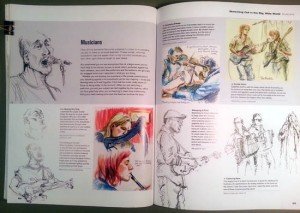 For me this is a fun section. At its core it’s a section that suggests different places where you can sketch people on location and it presents examples of just that. Lynne adds much more. She talks about the challenges of each venue, vantage points, choosing subjects, particular actions and attributes of people in that venue, and how to capture them on paper. I just had to include a photo of the page below as the pretty lady with a bunch of green pads on her head is Lynne herself, a selfie she drew from a mirror as she waited for her highlighting to take.
For me this is a fun section. At its core it’s a section that suggests different places where you can sketch people on location and it presents examples of just that. Lynne adds much more. She talks about the challenges of each venue, vantage points, choosing subjects, particular actions and attributes of people in that venue, and how to capture them on paper. I just had to include a photo of the page below as the pretty lady with a bunch of green pads on her head is Lynne herself, a selfie she drew from a mirror as she waited for her highlighting to take.
Different Styles and Approaches
ln this section Lynne puts the heart of the location sketcher, or maybe their brain. She talks about different styles, like Creative Color, Fluid Lines, and Less is More and other sections on how to quickly plan a sketch, how to paint first, draw later, and even how to place people in their environment. If you haven’t done a lot of street sketching, you’ll find this section valuable whether you draw people or not.
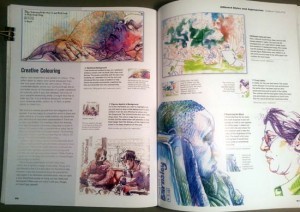
 People Move!
People Move!The achilles heel of people sketchers – those darn humans move when you’re trying to draw them. But consider the alternative. Better yet, experience it. Ask someone if you can sketch them. If they agree, they’ll stop moving. They’ll also stop being human as they sit up straight, look off into the distance and try to look regal. And then you’ll know – moving people aren’t so bad afterall.
Learning to work quickly is the answer to sketching moving humans and Lynne provides some tricks of the trade to help you do just that. She provides some basics about drawing quickly, talks about capturing poses that repeat and even about how to build composite characters as streams of humans move past you, all doing similar things.
Summary
This book is powerful and should be part of every location sketcher’s library. I confess that as a fountain pen guy, I admire Lynne’s multi-color style for sketching people and I ran out yesterday and picked up some Derwent Inktense pencils to give it a try. Maybe I’ll read her book again, copy a few of her sketches, and then hit the streets.
February 27, 2016
Quantity Your Way To Success In Sketching
You don’t have to look far to find some experienced artist telling you that the way to become good at sketching is to carry a sketchbook with you at all times and sketch whenever you have a few minutes. It’s a message that, sadly, seems to fall on deaf ears for most people.
I think I know why. We’ve all grown up thinking that “art” is something you hang on a wall. We’ve been taught that “do your best” is a good thing and when it comes to art this translates to “gotta do something significant” or some such sentiment. Whatever it is, this view causes most sketchers to sketch only “when they have time”, which translates directly into “not very darn often.”
And here’s the secret behind all the advice that experienced artist give about sketching constantly. That’s how they got good!!! Like it or not, you learn to draw by drawing. No class will make you good. No instructor can make you good. No fancy tools will make you good. The most these things can do is provide you with is help you get the most from that associate piece of advice – practice, practice, practice.
I thought I’d share a couple incidental sketches I did, where I was, and what I was doing as a practical example of how to fit sketching into a busy schedule. You see, I had an appointment to be interviewed as part of the Canadian citizenship process. Yep, I’m becoming Canadian (yippee!). Anyways, I arrived at the site of the interview about 15 minutes early. With nothing to do, I went into a coffee shop and ordered a cup. I could have just sat and drunk my coffee. I could have paged through innane Facebook posts on my cell phone. Or I could sketch.
Because I was traveling light, I had only the pen (Pilot Prera), a waterbrush with dilute brown ink, and small sketchbook I carry in my coat pocket. I got it out and started a quick sketch of the barista area of the coffee shop. I had less than 10 minutes before my interview which was on the 2nd floor of the building next door, and I had to drink my coffee too. Nevertheless, I did this small sketch of the area.
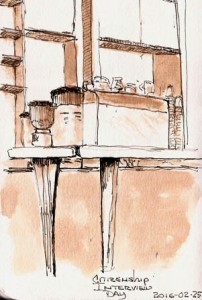 I had to stop sketching so I could get to the interview. When I arrived I found 50 or so people there ahead of me. Oh no…maybe an 8 AM appointment didn’t mean what I thought it meant. I sat down at the back of the room, a bit glum and expecting a long wait. Oh well, there were a bunch of sketching targets available so I got out my sketchbook. I started sketching a woman in the row in front of me. I was, maybe, a minute into this sketch…
I had to stop sketching so I could get to the interview. When I arrived I found 50 or so people there ahead of me. Oh no…maybe an 8 AM appointment didn’t mean what I thought it meant. I sat down at the back of the room, a bit glum and expecting a long wait. Oh well, there were a bunch of sketching targets available so I got out my sketchbook. I started sketching a woman in the row in front of me. I was, maybe, a minute into this sketch…
 …when a guy came out of a room. He read off a few names, including mine, and told everyone else to head into the “examination room.” All my potential sketching subjects got up and filed into the room to take an examination to see if they knew who the first Prime Minister was, who the current Prime Minister was, and whether they knew what the heck a constitutional monarchy was. You see, if you’re old, and filing for citizenship, they realize you’re not smart enough to be taking exams so I was exempted from that exercise.
…when a guy came out of a room. He read off a few names, including mine, and told everyone else to head into the “examination room.” All my potential sketching subjects got up and filed into the room to take an examination to see if they knew who the first Prime Minister was, who the current Prime Minister was, and whether they knew what the heck a constitutional monarchy was. You see, if you’re old, and filing for citizenship, they realize you’re not smart enough to be taking exams so I was exempted from that exercise.
I added a few lines to the sketch before a woman came out and called my name. I was being called for my interview. So, two sketches, done during time frames that most wouldn’t consider as a ‘sketching session.’ You’re right; these sketches are not great. But they were both fun and good practice. This is what all those experienced artists are talking about. Fill your hurry up and wait time with little sketching sessions and when you do get more time to sketch, you’ll be better at it because you did those little sketches.
And what have you got to lose – that you’ll never be bored waiting for an interview? Oh, and the interview went well. The only thing between me and citizenship is the swearing in ceremony. I even got to tell them that I was a sketcher (grin).
February 25, 2016
Winter Food Court Sketching
My daughter’s was home from university for a week and we’ve had some snow storms. These two things combined to keep me from going out sketching. I was longing to do some so I headed out one morning to one of the big malls, and their food court.
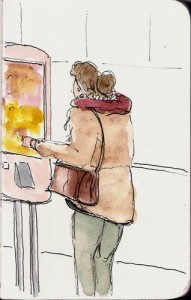 Food courts are great places to sketch people, either while they’re eating or when they’re standing in line to order. All food courts are not created equal, however. There’s a mall really close to my house that has two food courts and they’re both horrible sketching locations. Why? Because it’s hard to sit so you can draw people ordering and their tables are crammed together, making it hard to sketch without someone slopping their Big Mac sauce on your sketch (grin).
Food courts are great places to sketch people, either while they’re eating or when they’re standing in line to order. All food courts are not created equal, however. There’s a mall really close to my house that has two food courts and they’re both horrible sketching locations. Why? Because it’s hard to sit so you can draw people ordering and their tables are crammed together, making it hard to sketch without someone slopping their Big Mac sauce on your sketch (grin).
But the one I went to is the newest in our city and it’s big, very roomy and there’s just the right distance between tables and vendors to allow lines to form in a couple directions (providing different angles) and the view open.
 There’s not much to tell about the session. I got a cup of coffee and started drawing. I was using my Platinum 3776 with Platinum Carbon Black ink and I was sketching in a Stillman & Birn 4×6 softcover Alpha series book. Great combination for this sort of thing as I like to add a bit of color when I finish up and the S&B paper accommodates that nicely. I did time the session as I wanted to see how long I could keep doing it without getting tired. I’m a lazy sketcher and have to push myself to sketch for long periods of time. Come to think of it, long periods of time is a very relative term and, for me, “long periods of time” means relatively short. Quick sketching is rather intense as people are moving a lot, but I managed to draw for 45 minutes, punctuated by coffee drinking. I ended up with 14 sketches. Here’s some of them. I got tired of scanning. I told you I am a lazy sketcher (grin).
There’s not much to tell about the session. I got a cup of coffee and started drawing. I was using my Platinum 3776 with Platinum Carbon Black ink and I was sketching in a Stillman & Birn 4×6 softcover Alpha series book. Great combination for this sort of thing as I like to add a bit of color when I finish up and the S&B paper accommodates that nicely. I did time the session as I wanted to see how long I could keep doing it without getting tired. I’m a lazy sketcher and have to push myself to sketch for long periods of time. Come to think of it, long periods of time is a very relative term and, for me, “long periods of time” means relatively short. Quick sketching is rather intense as people are moving a lot, but I managed to draw for 45 minutes, punctuated by coffee drinking. I ended up with 14 sketches. Here’s some of them. I got tired of scanning. I told you I am a lazy sketcher (grin).
February 23, 2016
Sketching Polar Bears On A Glacier
Shari Blaukopf is a master at painting snow. I am not. Whenever I try I feel like I’m sketching a polar bear on a glacier. Everything is white. Yesterday I tried again, working from a photo I took from the window of the Maison Dorion-Coulombe, the site of our recent sketchcrawl. I always feel that my sketching from photos reflects too much my disinterest in sketching from photos but still, I should be able to do better. I thought I’d share the results with you anyways. Maybe I’ll get better at snow…some day.

Stillman & Birn Beta, Platinum 3776, Platinum Carbon Black
February 20, 2016
Stillman & Birn Softcovers: An Exciting Announcement
I am so excited to be writing this post. As many know, Stillman & Birn, my favorite sketchbook company, released a line of softcover sketchbooks not very long ago. Sadly, what most also know is that there were manufacturing problems with those books and they had to recall all of them, at great expense, from around the world. I applauded them for this as it hit their bottom line hard, but they didn’t want we artists to bear the pain of the problem.
Excepting the manufacturing problem, these softcover books looked like a dream come true. Available in all of Stillman & Birn’s great papers, in a variety of sizes, and with cover colors that reflected the paper type. The covers had an almost suede-feel to them. They weighed only 55-65% of the weight of the equivalent hardcover and they were much thinner. A dream come true for someone like me who carries several sketchbooks and walks a couple hours a day to sketching locations.

Stillman & Birn sofcover prototypes
Well, they’re BACK!!! Or at least almost back. Stillman & Birn says they should be available ‘real soon’ and they sent me a couple of their prototype books to get my opinion about whether the problems are fixed.
To that I can say, they are fixed and then some. I’ve gone through both of my prototype books, one page at a time, and the problems we saw with the initial release are gone. But it’s better than that. These books lay flatter than their early softcovers and certainly better than the hardcovers. I didn’t have to bend them backwards as you do with the hardcovers to get them to lay flat. They just do, though I still recommend going through each page, folding it out flat before using the book. I do that with any sketchbook, regardless of brand.
As I said, the books they sent me are prototypes. They came with Delta and Gamma paper so I could check both the 150gsm and 270gsm binding. The covers are the same material as the production versions but these aren’t color-coded; they’re prototypes. Still, they are amazing books and I’m downright giddy that I have them to use. I was planning to get somewhere to do a sketch for this blog post but a snowstorm prevented that. Truth is, everyone knows how great Stillman & Birn paper is so I decided it was more important to get this announcement into the ether. So here it is, without a sketch. Here’s the money shot of the books laying flat. Ain’t they gorgeous? Coming soon to an art store near you.

Stillman & Birn softcovers, laying flat.
February 16, 2016
Clowning Around With Thursday Sketchers
We were back at it on Thursday, as we met at the museum to sketch. Winter may drive us indoors but it doesn’t slow us down much.

Canson XL watercolor, Pilot Prera, DeAtramentis Document Brown
I found this little, three-inch high clown sitting in the bottom of a small display of early children’s toys. His right foot was missing but I made one up. He was lots of fun to draw.

Canson XL watercolor, Platinum 3776, Platinum Carbon Black
This lantern was nearly invisible and I have to wonder if it’s a forgotten exhibit. It was hanging on a dark wall, in the dark and it was black. Hard to see but it whispered ‘sketch me’ as I walked past. And so I did, or tried.
When I finished Claudette and Lisette were chatting, making plans to have tea and while they were packing up I did this quick sketch of a top hat in the case where we were standing. Then we headed for tea and had a great discussion about the value of sketching whenever we have a few idle minutes.
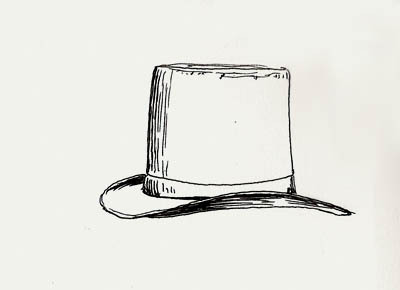
Canson XL multi-media, Platinum 3776, Platinum Carbon Black
February 15, 2016
February Sketchcrawl At Maison Dorion-Coulombe
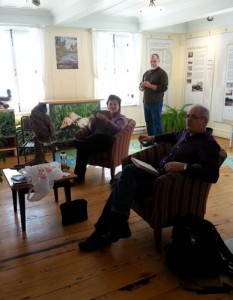
Celine, Yvan, and Rene drawing the Great Horned Owl
We did it! Our numbers were small, but we were mighty. I think a lot of people decided not to come because it was so cold (-40) and the news was warning everyone of the extreme cold.
Only six of us show up at Maison Dorion-Coulombe to draw last Sunday. One of them was my daughter, who is home from school. That was a special treat for me. When we arrived, Cassandra, staff member for the Société de la rivière Saint-Charles, greeted us and let us set up stuffed animals however we liked. For us, it was just nice to be warm.
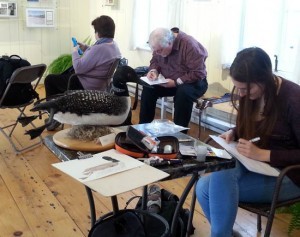
Celine, Pierre, and Jodie
Popular subjects were the Great Horned Owl and the Northern Loon but some ink was spilled documenting the river otter as well. I did a quick drawing of Cassandra at her desk. There was more chatter than normal between the sketchers, probably because we were so tightly clustered but that was fun. Generally we have to wait until lunch to talk.
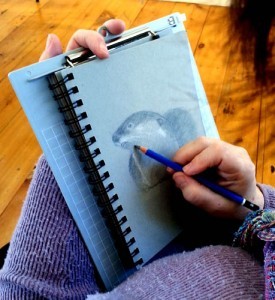
Celine drawing the otter
I’m including one sketch from each artist and displaying them smaller than I normally would. To see them larger, click on each photo. Sketchcrawls in winter are hard to plan because the venues are so limited but I hope you’ll come out and join us because they’re fun.

Pierre’s Loon

Yvan’s owl

Rene’s owl

Larry is a Loon
February 14, 2016
Sketching Too Quickly – Follow Up
In my post of yesterday I mentioned that I could “improve them by adding some shading” but that I was posting the quick sketches ‘raw.’ I’ve had a couple requests, asking me what I meant and/or what I did. Truth is, there are a lot of things one can do but in this case I kept it very simple. Here are three of them with some color added. Doesn’t change things much but it adds a bit of spice I think.
Sketching Too Quickly
I’ve found it amazing to watch the likes of Veronica Lawlor drawing dancers. It always seemed impossible. Then my friend Yvan started attending sessions at our museum where dancers and choreographers were practicing. The drawings he was producing were spectacular. I kept saying “Maybe I’ll come along” and always I chickened out. As a slow [understatement alert] sketcher this seemed impossible and I guess I was trying to avoid the frustration.
But I finally did attend one of those sessions with Yvan and two things became clear. The first was that I was right. It IS impossible. The second thing was a big surprise. I loved it and can’t wait to do it again. My sketches are sloppy and barely look like the women I sketched. One woman was wearing a huge African head scarf and she had bells covered with scarves on her ankles.
In all, I covered 14 pages with scribbles. Some of them look almost like people and I’ve never moved my pen so quickly, never strained my visual memory so much and after two hours I was completely exhausted. I could improve them by adding some shading but the point of the exercise was to draw quickly, without the time to think about it so I thought I’d present these as they were done, in the moment…in a moment.
I did some sketches of spectators. They didn’t move so much.
The rest of these came as a blur, or so it seemed at the time. If you squint a lot you might enjoy them. An open mind and closed eyes might be the best approach (grin). I can’t wait to do it again.
February 12, 2016
Love Me Some Harpsichord
I’m as close to a musical know-nothing as you can get but I really enjoy most classical music. Spare me the Schoenberg’s 12-tone scales and other modern attempts at cacophony but the rest is great. Sadly, I’m so ignorant of music that I can’t identify composers by ear, and can’t wax eloquently about how Beethoven’s 9th is such a great piece because… I just listen.
And so for me, it’s more about particular instruments. I love cello music of all kinds. I think classical guitar is sublime. But give me Bach played on a harpsichord and I am enthralled. So it was exciting for me to show up at the chapel for draw-the-carving session to find a guy practicing harpsichord. What could be better than listening to harpsichord music while sketching? Maybe sketching a harpsichordist while listening to harpsichord music and that’s just what I did. Unfortunately, when I finished I had to run off to the Musee de la Civilisation where there would be dancers to sketch. More on that tomorrow.

Canson XL watercolor paper, Pilot Prera, DeAtramentis Brown (and black)


